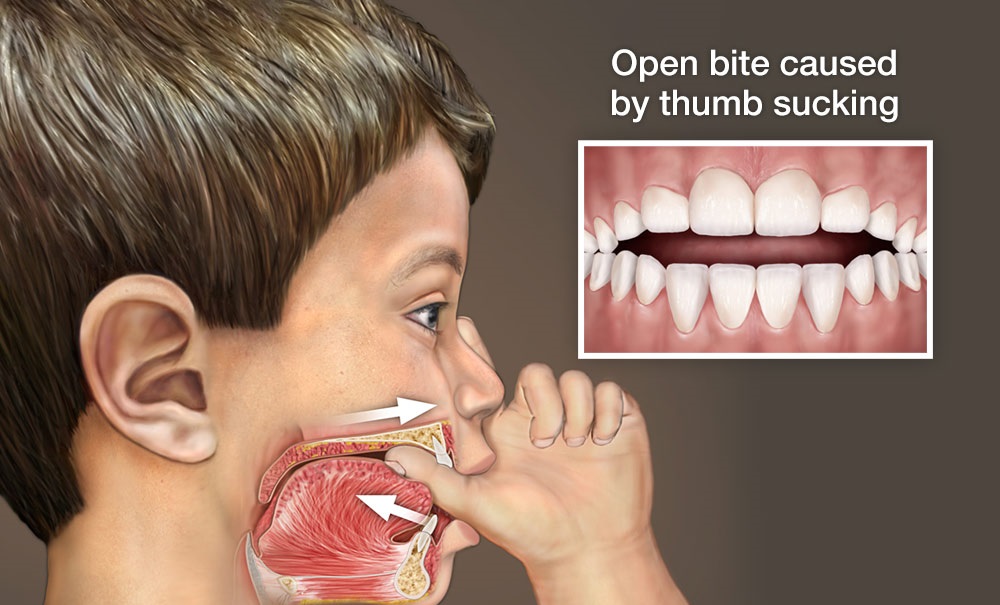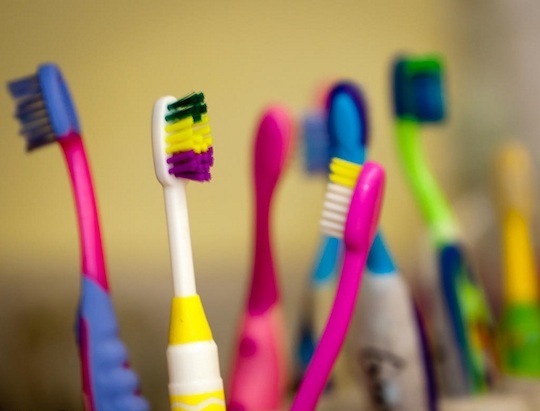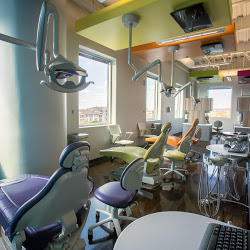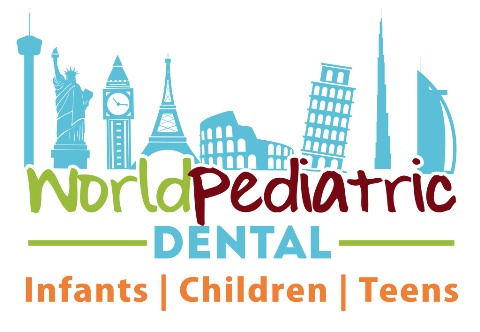 Like many parents, you may be concerned about your child’s thumb sucking, finger sucking or pacifier use. You may wonder if it is harmful, at what age it should stop or what could happen if your child does not stop. You can rest assured that sucking is one of an infant’s natural reflexes. They begin to suck on their thumbs or other fingers while they are in the womb. Infants and young children may suck on thumbs, other fingers, pacifiers or other objects. It makes them feel secure and happy, and it helps them learn about their world. Placing a thumb or another finger in the mouth provides some children with a sense of security during difficult periods, such as when they are separated from their parents, surrounded by strangers or in an unfamiliar environment. Since thumb sucking is relaxing, it also may help induce sleep. For this reason, young children may suck their thumbs in the evening or at other times when they are tired. Prolonged thumb sucking may cause problems with the proper growth of the mouth and the alignment of teeth. It also can cause changes in the roof of the mouth. Children who rest their thumbs passively in their mouths are less likely to experience difficulty than those who vigorously suck their thumbs. When an active thumb sucker removes his or her thumb from the mouth, a popping sound often is heard. Some aggressive thumb suckers may cause problems with their primary (baby) teeth. BREAKING THE HABIT Pacifiers can affect the teeth in essentially the same way as does...
The American Academy of Pediatric Dentistry (AAPD) has recently put together a wonderful resource for parents who may have serious questions about their child’s teeth/dentist. We highly recommend you visit this website – as it is a great tool for parents who may be getting ready to make their first dental check-up for their child or a parent who wants to prevent cavities in their child’s teeth. http://www.mychildrensteeth.org/education/ If you look under the tab “Education and Resources for your Family,” you will see great links to frequently asked questions by parents at the pediatric dentist, parent education brochures, and resources even for teens! We like this website because the information is clear, concise, and backed by many scientific studies. Happy...
Like many parents, you may be concerned about your child’s thumb sucking, finger sucking or pacifier use. You may wonder if it is harmful, at what age it should stop or what could happen if your child does not stop. You can rest assured that sucking is one of an infant’s natural reflexes. They begin to suck on their thumbs or other fingers while they are in the womb. Infants and young children may suck on thumbs, other fingers, pacifiers or other objects. It makes them feel secure and happy, and it helps them learn about their world. Placing a thumb or another finger in the mouth provides some children with a sense of security during difficult periods, such as when they are separated from their parents, surrounded by strangers or in an unfamiliar environment. Since thumb sucking is relaxing, it also may help induce sleep. For this reason, young children may suck their thumbs in the evening or at other times when they are tired. Prolonged thumb sucking may cause problems with the proper growth of the mouth and the alignment of teeth. It also can cause changes in the roof of the mouth. Children who rest their thumbs passively in their mouths are less likely to experience difficulty than those who vigorously suck their thumbs. When an active thumb sucker removes his or her thumb from the mouth, a popping sound often is heard. Some aggressive thumb suckers may cause problems with their primary (baby) teeth. BREAKING THE HABIT Pacifiers can affect the teeth in essentially the same way as does...
The American Academy of Pediatric Dentistry (AAPD) has recently put together a wonderful resource for parents who may have serious questions about their child’s teeth/dentist. We highly recommend you visit this website – as it is a great tool for parents who may be getting ready to make their first dental check-up for their child or a parent who wants to prevent cavities in their child’s teeth. http://www.mychildrensteeth.org/education/ If you look under the tab “Education and Resources for your Family,” you will see great links to frequently asked questions by parents at the pediatric dentist, parent education brochures, and resources even for teens! We like this website because the information is clear, concise, and backed by many scientific studies. Happy...
 DID YOU KNOW that dental disease (cavities and gum disease) is the most common childhood disease – FIVE times more common than asthma? If that’s not surprising enough, here are some more startling statistics: 47.4% of 3rd graders in Virginia have or had a (untreated or treated) cavity experience. Students miss as many as 51 million hours of school each year because of dental problems. Adults miss 164 million hours of work each year because of dental problems. Excellent oral health is considered a very important aspect of maintaining good overall health. Dental disease (cavities and gum disease), is the most common chronic disease of Virginia’s children, despite it being entirely preventable. Are you wondering how to prevent cavities and gum problems for your child? Contact us at 210-888-0700 and we would be more than happy to discuss it with...
DID YOU KNOW that dental disease (cavities and gum disease) is the most common childhood disease – FIVE times more common than asthma? If that’s not surprising enough, here are some more startling statistics: 47.4% of 3rd graders in Virginia have or had a (untreated or treated) cavity experience. Students miss as many as 51 million hours of school each year because of dental problems. Adults miss 164 million hours of work each year because of dental problems. Excellent oral health is considered a very important aspect of maintaining good overall health. Dental disease (cavities and gum disease), is the most common chronic disease of Virginia’s children, despite it being entirely preventable. Are you wondering how to prevent cavities and gum problems for your child? Contact us at 210-888-0700 and we would be more than happy to discuss it with...
 The experience of breastfeeding is very special for many new moms as they consider that time a valuable bonding experience between the mother and newborn child. Moms who are able to breastfeed also benefit for other reasons: they gain overall health benefits, oral health benefits, and cost-savings benefits. This blog will help explain the many benefits, for both mom and child, of breastfeeding. It is important to remember that the American Academy of Pediatrics (AAP) states that “exclusive breastfeeding, defined as giving an infant only breast milk – no water, no formula, or no other liquids or solid foods – is the norm against which all alternative feeding methods should be compared.” The 2012 AAP policy statement on breastfeeding and the use of human milk documents the many important reductions in health risks for infants and children, mothers, families and society that are attributable to breast-feeding. These advantages include developmental, economic, health, nutritional, immunological, psychological, social and environmental benefits. Why Breastfeeding is Important for Overall Health The policy statement of the AAP Section on Breast-feeding states that breast milk is the only source of nutrition a healthy infant requires for about the first six months of life. Breastmilk provides specific nutritional components for the child – providing immunological, anti-inflammatory, digestive and immune system benefits during the most vulnerable time in their lives. There are many reduced health risks for breastfed children including: Acute Otitis Media (Middle Ear Infections) Gastroenteritis and Diarrhea Lower Respiratory Tract Infections – ie. Pneumonia, respiratory syncytial virus (RSV) Necrotizing Enterocolitis Leukemia Sudden Infant Death Syndrome Asthma Obesity Type 2 Diabetes...
The experience of breastfeeding is very special for many new moms as they consider that time a valuable bonding experience between the mother and newborn child. Moms who are able to breastfeed also benefit for other reasons: they gain overall health benefits, oral health benefits, and cost-savings benefits. This blog will help explain the many benefits, for both mom and child, of breastfeeding. It is important to remember that the American Academy of Pediatrics (AAP) states that “exclusive breastfeeding, defined as giving an infant only breast milk – no water, no formula, or no other liquids or solid foods – is the norm against which all alternative feeding methods should be compared.” The 2012 AAP policy statement on breastfeeding and the use of human milk documents the many important reductions in health risks for infants and children, mothers, families and society that are attributable to breast-feeding. These advantages include developmental, economic, health, nutritional, immunological, psychological, social and environmental benefits. Why Breastfeeding is Important for Overall Health The policy statement of the AAP Section on Breast-feeding states that breast milk is the only source of nutrition a healthy infant requires for about the first six months of life. Breastmilk provides specific nutritional components for the child – providing immunological, anti-inflammatory, digestive and immune system benefits during the most vulnerable time in their lives. There are many reduced health risks for breastfed children including: Acute Otitis Media (Middle Ear Infections) Gastroenteritis and Diarrhea Lower Respiratory Tract Infections – ie. Pneumonia, respiratory syncytial virus (RSV) Necrotizing Enterocolitis Leukemia Sudden Infant Death Syndrome Asthma Obesity Type 2 Diabetes...
 Digital advances in Pediatric Dentistry are amazing. Not only do they provide for patient comfort, they create opportunities for Pediatric Dentists to provide better treatment. Digital X-Rays The cutting-edge technology of digital X-rays, also known as digital radiography, enables the Pediatric Dentist to take crisp X-ray images of the teeth, supporting bone and gums and download them instantaneously into the computer without delay, thus eliminating the need for environmentally-harmful film and chemical development. It also allows dentists to magnify and enhance images to review specific dental issues, and instantly transfer them to a patient’s file or dental specialist such as the child’s orthodontist. Digital X-rays are faster and safer than traditional X-rays, reducing the exposure to radiation by up to 90%. Digital Photography The intra-oral camera allows a patient to see what the dentist sees: their mouth from the inside. These photographs can also be enlarged and enhanced to show detail, creating better means of communication and documentation. Since they are not X-rays, there is no radiation involved. The camera is additionally used for “before” and “after” photos, presentations, enhanced diagnosis, insurance claims, and education or monitoring with parents and patients concerning overall dental health. Digital Panoramic X-Rays Panoramic digital X-rays show the health status of all the teeth in one film. Used primarily to show the upper and lower jaw, the TMJ and the sinus areas, to record existing condition and detect abnormalities of the developing teeth, salivary glands, cysts, displaced teeth follicles, etc. They are especially helpful for children who have orthodontic problems, or those who have medical or behavioral special needs...
Digital advances in Pediatric Dentistry are amazing. Not only do they provide for patient comfort, they create opportunities for Pediatric Dentists to provide better treatment. Digital X-Rays The cutting-edge technology of digital X-rays, also known as digital radiography, enables the Pediatric Dentist to take crisp X-ray images of the teeth, supporting bone and gums and download them instantaneously into the computer without delay, thus eliminating the need for environmentally-harmful film and chemical development. It also allows dentists to magnify and enhance images to review specific dental issues, and instantly transfer them to a patient’s file or dental specialist such as the child’s orthodontist. Digital X-rays are faster and safer than traditional X-rays, reducing the exposure to radiation by up to 90%. Digital Photography The intra-oral camera allows a patient to see what the dentist sees: their mouth from the inside. These photographs can also be enlarged and enhanced to show detail, creating better means of communication and documentation. Since they are not X-rays, there is no radiation involved. The camera is additionally used for “before” and “after” photos, presentations, enhanced diagnosis, insurance claims, and education or monitoring with parents and patients concerning overall dental health. Digital Panoramic X-Rays Panoramic digital X-rays show the health status of all the teeth in one film. Used primarily to show the upper and lower jaw, the TMJ and the sinus areas, to record existing condition and detect abnormalities of the developing teeth, salivary glands, cysts, displaced teeth follicles, etc. They are especially helpful for children who have orthodontic problems, or those who have medical or behavioral special needs...
Translate »






